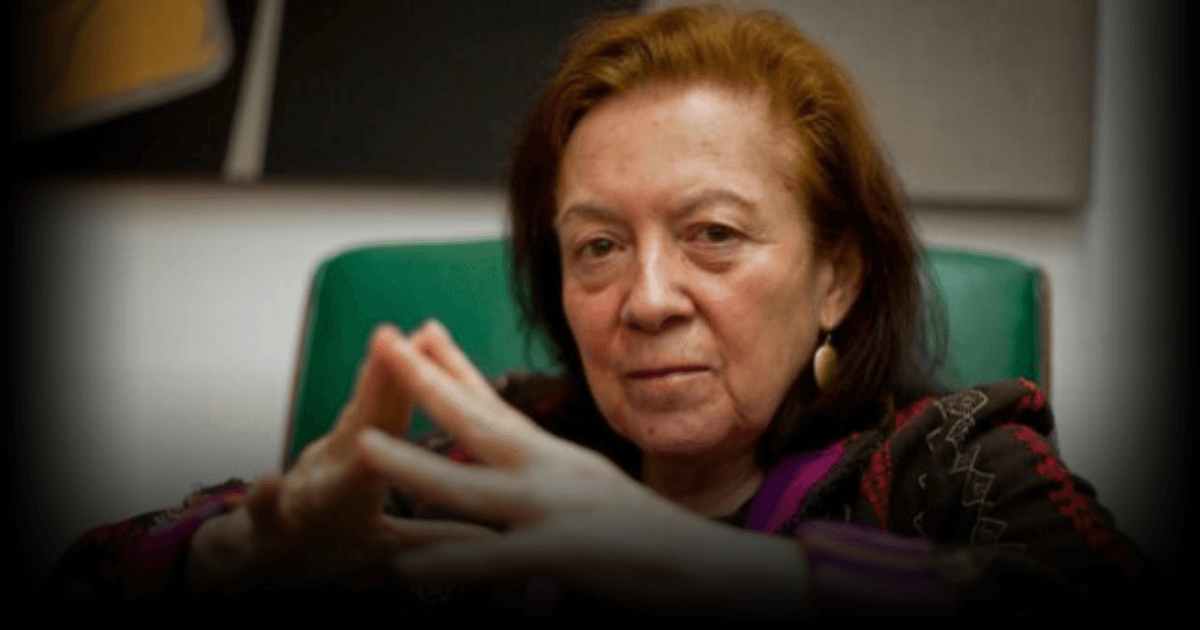
Contents
Early Life of Ana Mercedes Hoyos
On September 29, 1942, in Bogotá, Colombia, Ester Meza Gutierrez and Manuel José Hoyos welcomed a daughter named Ana Mercedes Hoyos into the world.
She belongs to a family where arts and culture are valued. Her father was an architectural engineer; therefore, she was influenced to pursue studies in art history.
Her early childhood led her to become a well-known Colombian painter and sculptor. Ana Mercedes Hoyos was associated with modern art.

Hoyos explored the culture and multiculturalism of Colombia through her work. Hoyos completed her schooling at Colegio Marymount in Bogotá.
During her high school years, she took private classes with Luciano Jaramillo. To study plastic arts, Hoyos was admitted to the University of the Andes(Universidad de los Andes).
At last, Ana Mercedes Hoyos continued her studies at the National University of Bogotá (Universidad Nacional de Bogotà), but she did not complete her studies.
At the University of Antioquia in 2000, Hoyos was given an Honoris Causa M.A. degree in visual arts.
Personal Life of Ana Mercedes Hoyos
In 1967, Ana Mercedes Hoyos got married to an architect named Jacques Mosseri Hané, and two years later, their daughter Ana was born.
They spent a month in New York and explored pop art at exhibitions before returning to their home country.
The technical characteristics of Hoyos’s art elicit an exceptional ability to combine artistic expression with social sense, giving her a permanent impression on the art world and strengthening her longevity as a visionary Colombian artist.

Hoyos experimented with different artistic styles in her early career. When she uses lively colors to explore her abstract art, it boosts a turning point in her life and creative paths.
Her works have very lively, strong, flat colors. At the National University of Colombia’s School of Fine Arts in Bogotá, she imitated her artistic training.
Hoyos traveled abroad throughout her life; she was inspired by different cultures of art from several nations. Ana Mercedes Hoyos was also studying painting techniques in Italy.
Notable works and achievements of Ana Mercedes Hoyos
From the 1960s onwards, Hoyos began her career in a pop art style because her art was very close to the pop movement; later, in the 1970s, she went into the abstract.
As a profession, her career began as a teacher at her former university, the University of the Andes. Hoyos taught there from 1961 to 1965.
Ana Mercedes Hoyos was invited by the Japan Foundation to take part in a culture exchange program for painters in 1992. In 1993, one of her famous collections on Palenque was exhibited at Yoshii Gallery.
Read Also
USA President Bill Clinton also invited her to the White House in 2000 to participate in a conference on the topic “Culture and Diplomacy.”
The highly competitive nature of the Colombian art scene, it ultimately led her to make New York her second home.
With her fabulous interview in Newsweek, Hoyos captured the attention of North American people in 1988.
The acknowledgment led her to international recognition, as well as being invited to participate in the Biennale de Paris and the “Geometría Sensível” exhibition organized by The Museum of Modern Art at Rio de Janeiro with famous painter Roberto Pontual and other famous Latin American artists.
Hoyos was recognized internationally as one of the most famous series depicting geometric atmospheres; it is in geometric patterns and featured in large-scale paintings.
The paintings celebrated Colombian culture and also depicted social and environmental drawbacks such as poverty, inequality, and environmental degradation.
Hoyos also played an important, unique, and prestigious role as an artist when she was appointed as a Colombian Ambassador to UNESCO in 1993.
During this period, Ana Mercedes Hoyos promoted art and culture with the help of her position to deliver speeches and foster mutual understanding between nations.
Her standing as an artist and cultural ambassador helps her to improve art and cultural heritage on an international level.
One of the most significant influences on her art was her Colombian heritage, where she found lively colors, rich cultural traditions, and the native crafts of her motherland.
In 1966, Colombian painters began to exhibit. Hoyos starts her work with several billboards, oil buses, and urban landscapes that are characterized by strong colors and expressive forms that create visually captivating compositions.
Her geometric form of art helps to depict harmony and balance. The use of decadent colors in her art impacts the diverse cultural roots of her country.
In 1969, Hoyos’s first creation was the series Ventanas (windows). Many people consider it one of the most important paintings. This series also inspired abstract paintings.
This oil painting is usually small and square, in which horizontal, vertical, and diagonal lines frame an abstract landscape. This painting usually depicts the abstract style of painting.
She named it Atmospheres. This painter won the Caracas Prize at the Salon of National Artists in 1978 because of her Ventanas collection.
Hoyos won the first prize for her creation, Atmósferas (Atmospheres), at the National Salon of Visual Artists.
From 1987 onwards, Hoyos created a series of decorative works with the motifs of the national, still life of Palenque, and a series of papagayos based on the platones of Cartagena fruit sellers.
Palenque culture and domestic objects like doors and windows become predominant in her paintings and sculptures.
Between the years 1984 and 1987, still life became an exploration of art history and a tribute to a famous painter from the past.
By reconstructing some of their paintings, Hoyos’s study of history compacted her perspective on magical or intangible ethnic experiences into the European tradition.
Hoyos’s figurative work was inspired by Colombian folklore. In her art, she often incorporated Colombian folk traditions.
She was very determined to abolish the stereotypes of Latin American artists creating only political art. With the continuous transition from the abstract to the figurative or decorative.
Hoyos held several solo exhibitions in her country as well as abroad, among which are those of the Museum of Modern Art in Bogotá (Museo de Arte Moderno de Bogotá) in 1976 and “Ana Mercedes Hoyos, a decade (un decenio) 1970-1980” at the Colombian American Centre (Centro Colombo Americano) in Bogotá in 1981.
Ana Mercedes Hoyos won the second prize at the Museum of Contemporary Art (Museo de Arte Contemporáneo). In the next year, she got first place in the Environmental Spaces exhibition at the Museum of Modern Arts.
Through exploration of Colombia’s past, this artist produced a series of works on the Afro-Colombian community.
For this creation, Hoyos was mostly recognized all over the world. This is a tropical image, and it depicts the Caribbean coastal populations and vegetation.
Read Also
Through her still-life paintings, Hoyos has come to appreciate Afro-Colombian heritage, transferring from a veneration of the beauty of seductive favor to an appreciation of the cultural contribution and multicultural diversity of people who live in Colombia.
Hoyos’s career achievements impact her place as a leading figure in Colombian art.
Conclusion
The greatest outstanding painter passed away on September 5, 2014, at the age of 72, in her birthplace, the Santa Fe Foundation Clinic (Clínica Gundación Santa Fe).
The news of her death has been described as “deplorable” for world culture. In her lifespan, Ana Mercedes Hoyos was awarded over 17 national and international awards.
Her work has become a revolution in artistic style, not only in Colombia but also all over the world. Hoyos was considered a “great reference for the visual arts in the world.” This statement was given by the Ministry of Culture.
Colombian President Juan Manuel Santos mourned the death of the famous painter Ana Mercedes Hoyos. “It is a terrible loss for art in Colombia,” said the director of the Bogotá International Art Fair, Maria Paz Gaviria.
During her half-century-long artistic career, Ana Mercedes Hoyos emphasized a lot of artistic instability. Through her artistic works, people get the idea of creating something new because many artists get inspired by her paintings.
Her all-around art flourished all over the world, and everyone can relate because she uses multiculturalism in her art.
Hoyos earned a reputation as a leading figure in the field of arts in her country. Her art and culture were unique and powerful.
Her work not only adds artistic value but also the rich cultural heritage of her country. Her artistic contributions have had an impact on both Colombian and Latin American art history.
A new generation of artists is seeking to celebrate their cultural heritage while showing global issues through their art.
Although he is no longer with us, his artistic and cultural influence lives on, cementing his place as an eminent figure in the history of Colombian art.
Before her death in July 2014, Hoyos arranged for the collection of her artifacts, which are related to Palenqueros, to be donated to the U.N. University in Tokyo, with a small part to be donated to the National Museum of African American History and Culture.
At the Nueveochenta Gallery, an exhibition was hosted in 2014 where her rarely-seen works were featured.
Once Ana Mercedes Hoyos said, “All you have when you decide to be an artist is a responsibility to yourself and commitment to society.”
In an interview with Efe, Hoyos pointed out that her creations have a deep impact on slavery and its hereditament in America.




